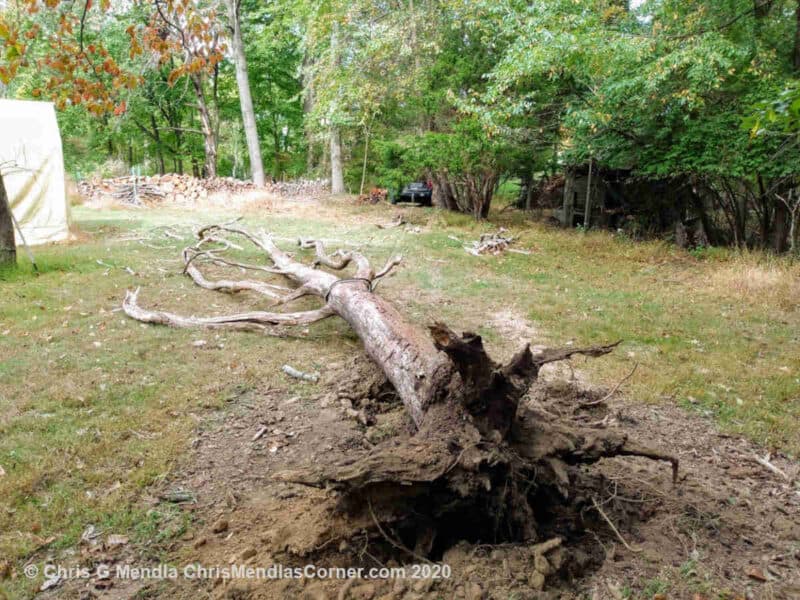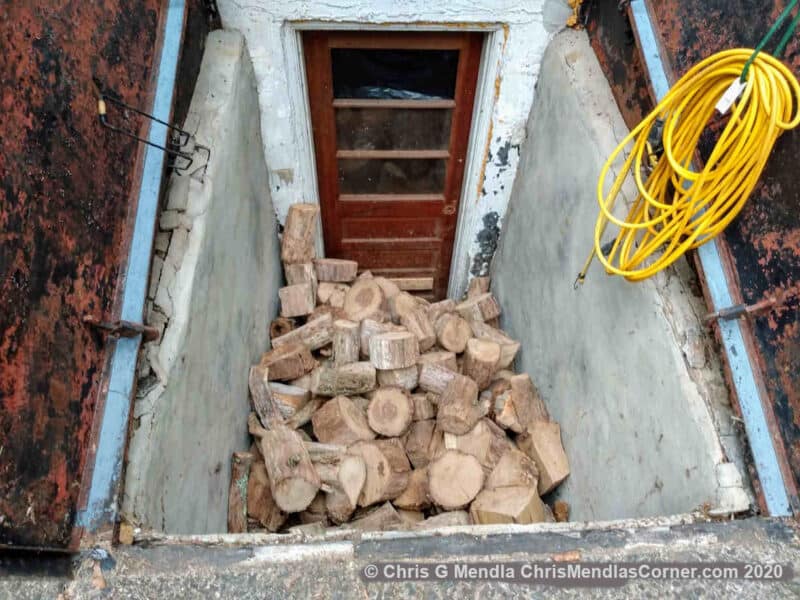Last Updated on 5 years by Christopher G Mendla
I had a dead Sassafras that was about 20″ at the base and about 50′ high. I was worried about widow makers from the dead branches. Also, I had to make sure that it dropped between a shed and my storage tent. I’ve had similar Sassafras trees that were hollow from rot which means not having a good hinge. I decided to try to pull the tree down before trying to fell it with a chainsaw.
WARNING – This can be VERY dangerous and can result in death, injury, property damage and voiding your vehicles warranty. This post is provided without warranty.
The Problem
In the photo below you can see two dead sassafras trees. There are a couple of trees behind them so I wasn’t worried about them falling on the shed in the background (I almost nailed that with a cherry tree two years ago).
I was concerned with a small shed to the left and a storage tent to the right. The space between the tent and shed was about 40′ or so.
I wanted to drop the trees on my terms to minimize danger to the tent or shed. Also, I’m not crazy about having a dead tree in an area where I spend a good bit of time.
I have two dead Sassafras trees. Both have lost all of their bark. I’ve been working on a LOT of oak that fell during a recent storm. However that will not season until at least next year.
I have a small shed and a Harbor Freight Storage tent in the danger zone if either tree were to fall.
In order to drop the trees, I would need a good hinge to guide them so that they wouldn’t take out the shed or tent. . I wasn’t sure how sound the trees were. They sounded ok when I hit them with a hammer but I wasn’t sure.
Options
A traditional wedge and back cut
The first option was felling it with a wedge and back cut. My concern was that if the tree was hollow or rotted then the wedge would not guide it properly. My other concern was the possibility of a dead branch falling while cutting it. (widow makers)
Pulling it down.
The other option was to pull it down with my 2005 Ford Explorer. I can easily drive the truck to the back of the property. I had a length of 5/8″ nylon and another 5/8″ line. That was a line that didn’t have the stretch of the nylon. I realized later that line was from my uncle’s boat and was purchased in the 1970’s. (Yep, I know. )
The plan was to try pulling it down by giving it a gentle tug. If it didn’t come down, I would use the tension to help guide it with a traditional cut.
Setting things up
Vehicle
I have a 2005 4 x 4 Ford Explorer. I’m not crazy about putting a strain on the drive train so the plan was to just try a gentle pull. The truck has the large receiver and I have a hitch with 2 balls on it.
Since the nylon can stretch, I left the full hatch open. It seemed better than keeping the hatch closed and risking a window.
I put the truck in four wheel low.
NOTE – In all likelihood, your insurance probably will not cover using your truck to take down a full sized tree. I could be wrong but I believe they would say “Tough luck”
Line
As I mentioned above I had 2 lengths of 5/8″ line. I attached them about 10′ on the tree with bowlines. The other end I attached to the balls on the hitch.
I used the old Boy Scout trick of holding a small stick at arms length and lining it up with the tree. You slide it down until the top of the stick is equal to the top of the tree. Turning the stick 90 degrees will give you a pretty good idea of where the top of the tree will be when it hits the ground. The line I had gave me another 30′ past that.
DANGER
There is a real danger that if the tree falls away from your truck, you could create a truck-tree trebuchet and find yourself hurling through the air.
That would be a bad thing. It would be funny if you got it on video but it would mess your day up or even kill you. In this case, the tree in question had a couple of trees directly behind it. In other words, there was a minimal chance that it could fall away from the truck.
If you were to try this, the maximum sized of a tree to pull down would depend on a number of factors such as:
- Your tolerance for risk
- The viability of felling it with a traditional cut
- The need to take the tree down.
- Your vehicle (Weight, tires, traction, tolerance for loss)
- Terrain – Can you get a vehicle in a good position.
- The tree – is it leaning? Can it fall backwards? How sound is it? Can you drop it without creating a ‘leaner’? . How long has it been dead? Is it hollow? What condition are the roots in?
Spotter
My girlfriend came over to spot for the attempted pull and/or cutting. “Hey dear, can you come over for a bit? I’m doing crazy sh*t again”
Execution
With Maryann at a VERY safe distance, I started the truck and put it in gear (automatic). Just putting it in gear was enough to start moving it. I heard Maryann yell that it was falling.
A couple of seconds later it was on the ground. The roots had snapped.
Potential problems
- This is dangerous. Maybe more so than cutting it down. You can damage property or cause injury or death.
- Damage to your vehicle may not be covered.
- Sassafras trees could have a tap root but it appears that it had rotted out in this case or it was a variety with just the lateral roots.
- There is a possibility of the tree breaking where you attached the lines. That can cause the upper part to fall in an unexpected direction.
- All lines stretch and have a breaking point. If you overload the line and it is stretched, it can become a deadly whip.
The root system is shallow, with prominent
https://www.fs.fed.us/database/feis/plants/tree/sasalb/all.html
lateral roots. Root depth ranges from 6 to 20 inches (15-50 cm).
Results
The tree came down easily and fell almost exactly as I had planned. The trunk wood was seasoned. That gave me about 3 weeks of fall burning for my woodstove.
I’ve found that Sassafras can be a little difficult to split. Instead of bucking it into traditional woodstove sized logs, I cut 4″ ‘wafers’. That required a little more cutting. However, It was easy to split the wafers into a couple of pieces to make woodstove sized chunks.
The wood was going right into my bilco area since the woodstove is in the basement.
WARNING – This can be VERY dangerous and can result in death, injury, property damage and voiding your vehicles warranty. This post is provided without warranty. Nylon and other ropes stretch and can be deadly when they break.
Update – Oct 2020 – Pulling down the second tree.
I pulled down the second dead sassafras tree that was adjacent to the first tree. This tree had about a 4 degree lean opposite from where I wanted it to fall.
The effort required to pull it past 0 degrees and drop it was minimal. It fell where I wanted. In the second photo, you can see the storage tent to the left and the old shed to the right. This time I put 4×4’s as chocks behind my rear wheels to try to stop being pulled back but they weren’t needed.

The Results
Below is what I got from the two trees. I cut the trees into ‘discs’ instead of standard wood stove sized logs. That required more cuts but it meant that I didn’t have to mess with splitting it. Since the trees were dead for a while, they are already seasoned. I did split some of the large pieces so they would fit in the stove more easily.
This is probably about 3-4 weeks of early season burning. Once the temperature drops, I usually run the stove constantly. It is about 30,000 BTUs. My house heater is about 170,000 BTUS. Consider that the stove is constantly throwing 30k while the furnace only runs periodically .
I accomplished:
- Dropping two trees that were posing a danger to buildings and people
- Got rid of two eyesores.
- Added about a month’s worth of seasoned firewood.






